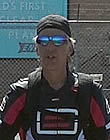|
|
This topic comprises 4 pages: 1 2 3 4
|
|
Author
|
Topic: Home speakers vs. Cinema speakers
|
|
|
|
|
|
|
|
|
|
|
|
|
|
|
|
|
|
|
Manny Knowles
"What are these things and WHY are they BLUE???"

Posts: 4247
From: Bloomington, IN, USA
Registered: Feb 2002
|
 posted 10-17-2012 12:33 PM
posted 10-17-2012 12:33 PM




I don't remember the entire argument with great accuracy (it was a while ago) but I do recall that one factor alone did not make an environment near- or far-field. Rather, *several* items on a sort-of "checklist" had to be true before declaring something far-field, and one of them was that in a far-field the SPL drops -6dB when distance is doubled. Seems like it would depend on the size of the auditorium. My hunch is that most cinemas are too small to reach this threshold.
Yes, we're sitting further away from cinema loudspeakers than home theatre speakers (or studio monitors) so I can understand the impulse to make that (alone) the determining factor, but they're also a heck of a lot bigger/more powerful, and a (good) cinema is relatively dead so, when we factor in scale, the overall effect is similar to near-field listening.
[Note: I'm only referring to the main loudspeakers. I'd readily accept that cinema surrounds are far-field.]
I've never heard or read anything about the distance between the speakers being a factor. This is not to say that it isn't -- I'm not claiming to be an expert in this area -- just that it's yet another qualifier on a growing list of criteria of near/far-field differentiation.
Let's say for a moment that the distance between speakers versus the distance between listener and speaker was the litmus test for this. It would mean that some home theatres are near-field and some are far-field, depending on where the speakers are placed. It would also mean that some seats in a cinema may be near-field, while most would be far-field. And, yet, a major point of cinema standardization is to render all seats essentially equal. Obviously, they are not all equal, but is there really *that* much of a difference in a well-designed cinema?
I honestly don't know the answer, but the question is interesting. It all makes me curious what a definitive "text book" answer would be.
| IP: Logged
|
|
|
|
|
|
|
|
Steve Guttag
We forgot the crackers Gromit!!!

Posts: 12814
From: Annapolis, MD
Registered: Dec 1999
|
 posted 10-18-2012 10:32 AM
posted 10-18-2012 10:32 AM




It isn't really a debate...one need to really look at what one is trying to do and what the tools available are to do that job. Any debate can be over what one thinks happens to be the best sounding this or that.
quote: Jim Henk
Have heard people ask that question before, and even seen and heard people (strangers) point to surrounds on the wall, and tell each other that they're the same as what you have at home.
Again, one need look at what was being done with surrounds when "bookshelf" speakers were used as surrounds (or even worse quality...say just 8" woofers in a box)...Surrounds started out as an "effects" channel only...with rare exception, there was no fidelity sent to them where any sort of accuracy was needed. This was true for all formats before digital except 70mm magnetic, Fantasound, Cinerama...etc...those sorts of formats. Even 35mm magnetic put relatively small demands on the surrounds and lack of frequency response would only help hide the hideous 12KHz pilot tone.
The SVA sound track with surrounds had an inherent frequency response of 100Hz-7KHz...not exactly high-fidelity. Its dynamic range was also VERY limited. It wouldn't be too much of a challenge for a "home" type speaker to reproduce. Furthermore, they were place, relatively, close to the listener and recommended to be in great quantity thereby lessening the demand on each speaker. The business side of things would also look at surrounds being 8-24 speakers per auditorium (by and large)...so lowering the cost per unit would be an incentive to not go crazy with them.
With digital audio...all of that changed. The surrounds are now a full range channel with potentially full power demands too. A bookshelf speaker with a typical 88-90 db 1W/1m will not be able to deliver. As we move into dividing the surrounds up into smaller channels...each channel now has more demanded of it since only one or two speakers may need to "reach" the entire auditorium.
As to the stage speakers...the big magical thing about cinema speakers was, traditionally, that they concerned themselves about
1) Playing through a screen
2) Must reproduce dialog with high intelligibility.
In 2-way systems, the 500Hz crossover point was not chosen by chance...it was done to keep the crossover region as far away from the dialog as practical. Getting the timber of two different drivers to be identical is near impossible...which is another reason to keep crossover points away from the dialog region.
With 3-ways...we now have the crossover point, more often than not, in the dialog region (mid to high) and it is a reason, I feel that most 3-ways suck and don't have the clean crisp dialog of a good 2-way. QSC had done a VERY good job on their 3-way/4-way systems...most others have not. I'll take a good 2-way over a cheap 3-way, every time.
So keep in mind what you are trying to reproduce when choosing a speaker.
Make sure you have sufficient efficiency in the speaker and enough amplifier power behind it for your room. That will require math but it isn't that hard.
The other issue is playing through a screen. Domed tweeters generally don't do so well and projecting through the screen...they are more likely to splatter off the screen. Even those that have tried ribbon tweeters found they need to put a horn in front of them.
I can generally tell when a horn is being used versus something softer, like a dome. I will say, the newer shorter horns, like those on QSC (and others) tend to make the horn sound less pronounced.
Like so much in life, there are compromises when choosing equipment that best achieves as many goals as possible.
I would caution against going with speakers that are too large for the room because I've found that they will never image right...one has to sit back far enough for the various points of the speaker to sound like one.
As I am considering my own home theatre...I'm leaning towards using Altec 604 drivers...2-ways in a coaxial formation and then making suitable cabinets similar to the Altec 620. But that is me.
| IP: Logged
|
|
|
|
|
|
All times are Central (GMT -6:00)
|
This topic comprises 4 pages: 1 2 3 4
|
Powered by Infopop Corporation
UBB.classicTM
6.3.1.2
The Film-Tech Forums are designed for various members related to the cinema industry to express their opinions, viewpoints and testimonials on various products, services and events based upon speculation, personal knowledge and factual information through use, therefore all views represented here allow no liability upon the publishers of this web site and the owners of said views assume no liability for any ill will resulting from these postings. The posts made here are for educational as well as entertainment purposes and as such anyone viewing this portion of the website must accept these views as statements of the author of that opinion
and agrees to release the authors from any and all liability.
|

 Home
Home
 Products
Products
 Store
Store
 Forum
Forum
 Warehouse
Warehouse
 Contact Us
Contact Us




 Printer-friendly view of this topic
Printer-friendly view of this topic






![[Big Grin]](biggrin.gif)




![[thumbsup]](graemlins/thumbsup.gif)
![[Smile]](smile.gif) (And right.) The classic definition of near field audio is any point where you are at or closer than, the distance between speakers. So, for the majority of auditoria, the main seating area is NOT near-field.
(And right.) The classic definition of near field audio is any point where you are at or closer than, the distance between speakers. So, for the majority of auditoria, the main seating area is NOT near-field. 





